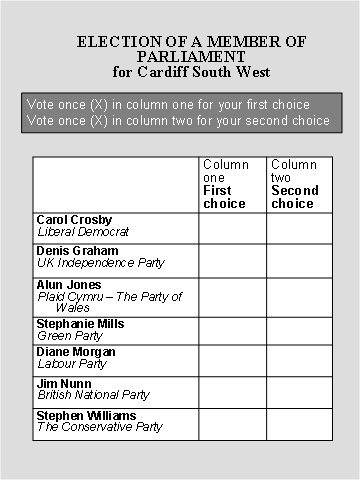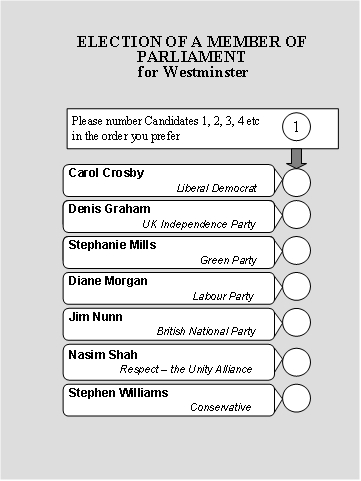 A key part of the text that glues David Cameron and Nick Clegg together is the commitment to hold a referendum on introducing ‘the Alternative Vote’. But Patrick Dunleavy argues, there are two forms of this system, with very different implications for British politics. Should voters be allowed to choose which they want?
A key part of the text that glues David Cameron and Nick Clegg together is the commitment to hold a referendum on introducing ‘the Alternative Vote’. But Patrick Dunleavy argues, there are two forms of this system, with very different implications for British politics. Should voters be allowed to choose which they want?
Some of our readers have asked – why do we have to have a whole referendum restricted just to a choice between the status quo ‘first past the post’ voting system for MPs and the Alternative Vote? The is a simple answer – we have to have a referendum on ‘Alternative Vote’ because this is what the Conservative-Liberal Democrat coalition agreement says must happen. Without honouring this pledge, the coalition cannot continue in being. The government has now announced a fast track route to the referendum and the Electoral Commission has already asked for tenders on research on the question wording to be put to the electorate.
One key issue that does not seem to have been considered by Nick Clegg’s office is exactly what a commitment to ask about the ‘Alternative Vote’ means? Most people think of the Australian version of AV described in our Simple Guide to Electoral Systems. But there is a simplified and British version of AV that has been used very successfully in London to elect the Mayor (where it is sometimes called the Supplementary Vote). Here people can express a first preference (marking an X in a first preference column) and a second preference (marking a second X in their second preference column. They do not need to use numbering, which makes it easier to run this voting method alongside other elections that use X voting – like the European Parliament, Scottish and Welsh Assembly, the London Mayor and Assembly elections, and the English local government elections.
Ballot paper for the London form of the Alternative Vote (also called the Supplementary Vote)

The London form of AV also has the great advantage that it creates a run-off between the top two candidates in a local constituency – only one of them can win. By contrast it is theoretically possible that under the Australian form of AV, candidates initially placed third, fourth or even fifth in the electorate’s first choice preferences could none the less end up defeating higher order candidates. What is more, the views of people who cast many preferences by numbering all the candidates can have more weight in determining the result than people who only cast a couple of preferences.
Ballot paper for the Australian form of the Alternative Vote

This might seem unlikely – and it rarely happens in Australia. But when you are making constitutional decisions, you have to plan for the long term (indeed for ‘all time’) and to plan for all possible contingencies. So although the referendum has to be on some form of AV, should it be on the Australian form of AV, or the London form – perhaps we could vote on that!
How might the parties line up on this issue? The Liberal Democrats will be immediately suspicious, because part and parcel of their secret wish is that once people get used to numbering candidates 1, 2, 3, 4 etc. then it will in future be an easier sell to the public for the Lib Dem favourite voting system – the Single Transferable Vote (STV). For a quick description, see our Simple Guide to Alternative Voting Systems). STV uses numbering of candidates too.
Yet the Conservative opposition to AV is premised on the same belief – this time a deep dread that AV will be the thin end of the wedge for fully proportional voting system. Yet if the vast bulk of Tories and the Conservative press campaign in full flood for a ‘No’ vote in the referendum, the coalition’s prospects will look distinctly shaky – whether the reform passes of fails. If it passes, Cameron will come under huge pressure from his right wing for more distinctive ‘blue water’ policies. If it fails, the Liberal Democrat grass roots are staring at another sterile period of campaigning against the weight of the current voting system, maybe for another two decades or more if the reform loses badly.
Could shifting the meaning of ‘Alternative Vote’ to embrace the London version of the system solve the conundrum for ministers? Opposition from Tory MPs would surely be massively reduced. The example of Boris Johnson’s success in winning the London mayoralty, and the restriction of potential winners to the top two parties, would blunt the fears of AV as a thin end of the wedge. Labour support for reform would also increase – after all they introduced the London form of AV.
The London version of AV does everything that the Australian version of AV does, and does it better. Most MPs will still need to reach out to people in other parties to win a local majority within their constituency. Their democratic legitimacy would be vastly increased, as the London mayors (Ken Livingston and Boris Johnston) have found. Every MP would be the authentic voice of their area once again. That is the key prize to win, and a shift to the London form of AV might guarantee that it can indeed be won.





A true runoff would surely be better than the London voting system-how can ones secondchoice be meaningful if you have no knowledge who your second choice would be. In the French 2002 election few left wing voters would have marked Chirac as their second choice, even though in the runoff they were able to hold their noses and vote against Le Pen…
I think this is the first time I’ve heard the Supplmentary Vote system called the London form of AV!
Supplementary Vote doesn’t do everything Alternative Vote does. AV guarantees that all MPs have the backing of the majority of voters – SV does not because any second preferences other than for the first two in the first round get discarded completely. AV does an enormously better job of finding the top two preferences of the voters than a system which just takes the top 2 after the first round – witness the 2002 French Presidential election and Jean-Marie Le Pen’s entry into the second round and subsequent abject showing. MPs democratic legitimacy may be increased but only marginally because it’s still relatively easy for an MP to have the backing of less than half of their constituents.
AV is a far from ideal system that can exaggerate swings, as predictions from the 1997 election show, but it is vastly superior to either FPTP or SV. It’s also the absolute minimum level of reform that the LibDems (with two third of the Conservative vote but one fifth of the Conservative representation) will accept, so if David Cameron doesn’t want to become a minority administration he can’t go to SV, or the ‘London Form of AV’ as you’re misleadingly calling it.
The big problem with the “London version” of AV is that you have to try to second guess who is going to be in the final round so that you can then cast your second vote for one of them. If you don’t, or get this wrong, then your second vote ends up wasted (unless your first choice gets into the second rounds).
This isn’t just a theoretical problem, but a real one we’ve seen played out each time in the London elections were large numbers of second votes ended up unused.
And that’s why I suspect your comment about Nick Clegg & co not considering this option is wrong; it’s more a case of they’ve seen how it works in London and have seen the problems.
It’s Alternative Vote, probably without the compulsion element. It’s definitely not the Supplementary Vote, which is neither simple nor reliable.
The biggest strength of AV is it almost eliminates the need for tactical voting. Supplemental Vote, due to it’s massively increased guesswork requirement, increases tactical voting substantially, reduces voter choice, encourages a two party duopoly to a greater extent than FPTP and is merely a figleaf for lesser parties.
Trevor, we ended up with AV because the Tories are committed to single member constituencies for some inexplicable reason, and no one seems to have explained to them they were introduced by Labour to help Labour. The Lib Dems prefer STV, but that wasn’t on the table, AV, being simple and preferential (properly preferential, not guesswork preferential), is a step in the right direction and elminates the worst excesses of AV.
Patrick, Supplemental Vote is not, and has never been, the “London Form of AV”, it’s not a preferential system, at all, and is frequently referred to in Lib Dem circles as the bloody Stupid Voting system. There is no chance that this is what Clegg is proposing, and there is no chance the Lib Dem party would accept it, at all, under any circumstances. Not going to happen.
Opposition from Tory MPs might be reduced, but it’d also kill the referendum dead. That might be what some Tories want, but it’d also end the coalition. AV is what the deal says. Not Supplementary Vote, not a different varian of contingent voting, but a properly preferential Alternative Vote, which is clearly understood and in use in most parties internally.
If some Tory ministers think it’d be acceptable, they need to think again, as one of the LD voting reps who voted for the coalition, I know full well it’d end the coalition deal dead.
AV does not “almost eliminate” the need for tactical voting. It merely repositions the point where tactical voting comes in to play. With FPTP, tactical voting is significant if a third party gets at least one vote. With AV, it is significant if a third party gets at least 25% of the vote.
The LibDems got 23%, and are climbing upwards. So you can expect tactical voting to continue to be a problem.
I wish someone in government would look at approval voting or score voting, if proportional representation is truly out of the picture.
Interesting idea. Why not go further and rename the Additional Member System (AMS) a form of Alternative Vote. Isn’t that AV plus?
It makes you wonder how on earth we ended up with AV as the only option for reform. The Australian version is complicated, unreliable, and does not necessarily end up being more proportional. At least the London AV system is easy, to use and delivers reliable and strong mandates. Even if it doesn’t guarantee more proportionality.